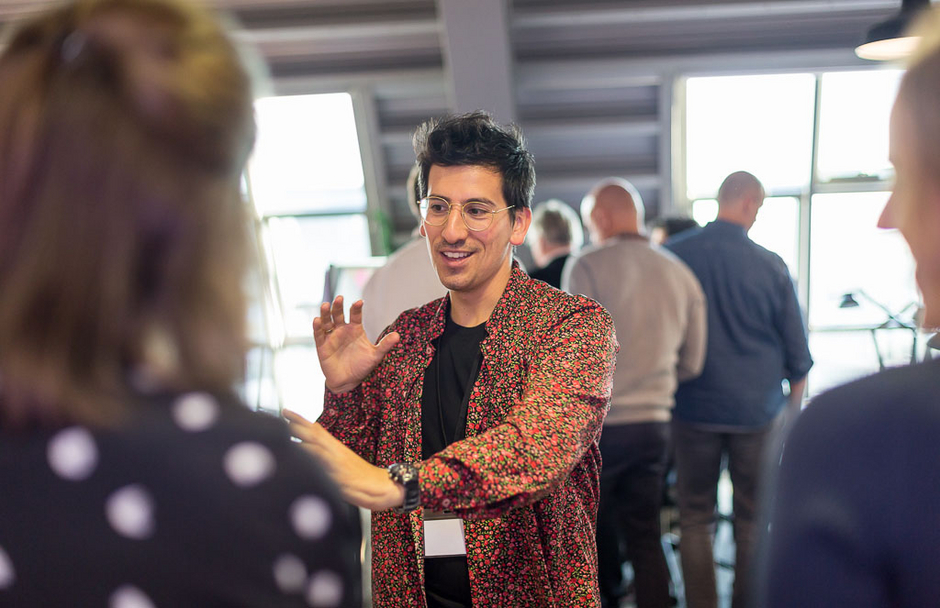Rethinking law and shaping the future of the justice system
From different legal backgrounds, the three HPI D-School alumni Alisha Andert, Lina Krawietz and Joaquín Santuber joined forces in 2018 to actively shape the legal system with a design and human-centered approach. They recognized that there was potential for innovation in the legal field and founded their initiative, "This is Legal Design".
Due to globalization and technical innovations, life and work structures are also changing in the legal sector, which means that legal companies, law firms and lawyers are increasingly confronted with new challenges. In this context, legal design methods are setting important innovations in the legal system. In this interview, the three HPI alumni talk about their creative work in the legal field at the interface of people, law and technology.
In 2018 you founded the initiative "This is Legal Design" with the aim of creating innovation and creative rethinking in the legal sector. Part of your work is to train law firms, legal departments and lawyers in legal design. What is legal design? Does it differ from Design Thinking?
Legal Design can be seen today as an umbrella term for different innovation approaches related to the creation of new —or changing existing— (digital or analogue) products, services, and systems that solve a legal need. Among that repertoire of methods and tools, Design Thinking is certainly an important one. Because of its large adoption, Design Thinking is often the “entry point”, and for many practitioners, human-centered design is one of the pillars of Legal Design. Other methods are, to name a few, information design, pattern languages, data-driven design, experts design, etc.
Together with practice, Legal Design is also an emerging academic discipline, with two international conferences in the last years, in which we presented the research work we conduct together with the HPI-Stanford Design Thinking Research Program. We stay close to new research produced at the HPI, translate it into Legal Design, and contribute our own research outputs and case studies.
Furthermore, Legal Design is positioned as a field that influences the discussions around technology, law and society. In this sense, Legal Design is setting directions and priorities at different levels. In this context, we have been invited to take part in different panels and roundtable discussions, from politics to education.
To summarize, our company is positioned from three angles, providing services as a consultancy, doing academic research, and running a think-thank.
At first glance, law, creativity and innovation do not go together. Is it a cliché that instead of welcoming progress, the legal sector continues to rely on predominantly conventional methods? What examples of legal innovation using legal design already exist?
Indeed, law is a big ship, thus steering such a big ship takes time and energy. This also speaks of legal services as a network of private-public organizations, so changes require some level of coordination beyond individual institutions. Despite that, we can see a growing interest in taking a human-centered approach to innovate within the legal system. That interest is present not only in legal departments and law firms, but also in the public sector, in law making and justice administration.
In this system of experts —lawyers to lawyers— often end users of the legal services were left out. And by user we mean the business management in a firm, the client, or the citizen. This is changing. More and more, the legal system is understood to serve people with no expertise in legal matters, that do not speak “Legalese”, yet have jobs to be done that have so far required the intervention of a lawyer, with legal not being the end, but a means. So many of our clients are finally asking themselves: how do we shape our services to serve the end goal of our client —beyond the specific legal need? We believe, the best approach to act on that question is through human centered and Design Thinking.
A classic example for Legal Design projects is the concept of visual contracts. An interesting example that particularly sticks out here: comic contracts. This legal redesign story is about working contracts for fruit pickers in farms in South Africa. Because of the often very limited skills to understand written text, in the context of the user —fruit pickers— normal contracts were ineffective. Once this problem was identified, they designed a cartoon-like contract using illustrations and short sentences in speech bubbles. This made the content accessible and easy to act on.
To also give you an idea of what Legal Designers do beyond re-designing written rules and regulation: We’ve also worked on things like identifying and defining innovation and digitization needs of a “big law” law firm, managing the design and development of a legal tech platform, which helps small and medium-sized enterprises navigate through the complexities of COVID-19 state aid programs, and shaping the concept and processes for a digital legal department in a tech company. Recently, a client came to us asking: how could we design a compliance program that encourage employees in a firm to take care of the company’s “compliance health”?
What lasting changes in the legal system do you wish for and how can these be realized by applying your legal design approach?
Legal services that serve people. This is a broad vision of the future of legal services, yet a strong core from where to start.This means that legal interfaces are designed with the non-expert user in mind. This is also valid for business, improving cross department collaboration and understanding legal departments to be business enablers instead of a hinderance.In consumers-oriented services, legal touchpoints like T&Cs or Privacy Policies should be a source of trust and engagement —we care about your data and your rights— instead of an obstacle.This is also relevant for Courts and dispute resolution. Better justice and a system that represents this can solve pressing human-needs and leverages digital technologies.
We believe the legal system plays a fundamental role in our society which sometimes we give for granted, and yet it is so much value to untap in the future if we are able to bridge the gap between law and citizens.
Can you imagine how your work with "This is Legal Design" will change in the future? What new challenges would you like to face and develop innovative solutions for?
Our work changes quite rapidly, with the legal sector —as a late adopter— catching up with the developments others made in the previous year and decades. In this sense, our work draws on extensive knowledge and experiences from somewhere else —technology in the financial sector and professional services in general— to bring the legal services transformation up to speed.
There is still much to learn. However, legal values such as the rule of law, access to justice, and social peace operate on different scales and challenges than traditional services. In this regard, the challenge we face is not just about designing for efficiency and user needs, but also social impact. Moreover, it is about financial viability, technical feasibility, user’s desirability, and social sustainability.
Contact Alisha Andert, Lina Krawietz and Joaquín Santuber on LinkedIn.
Photos: This is Legal Design
The interview was conducted by Anna Dotzek.



